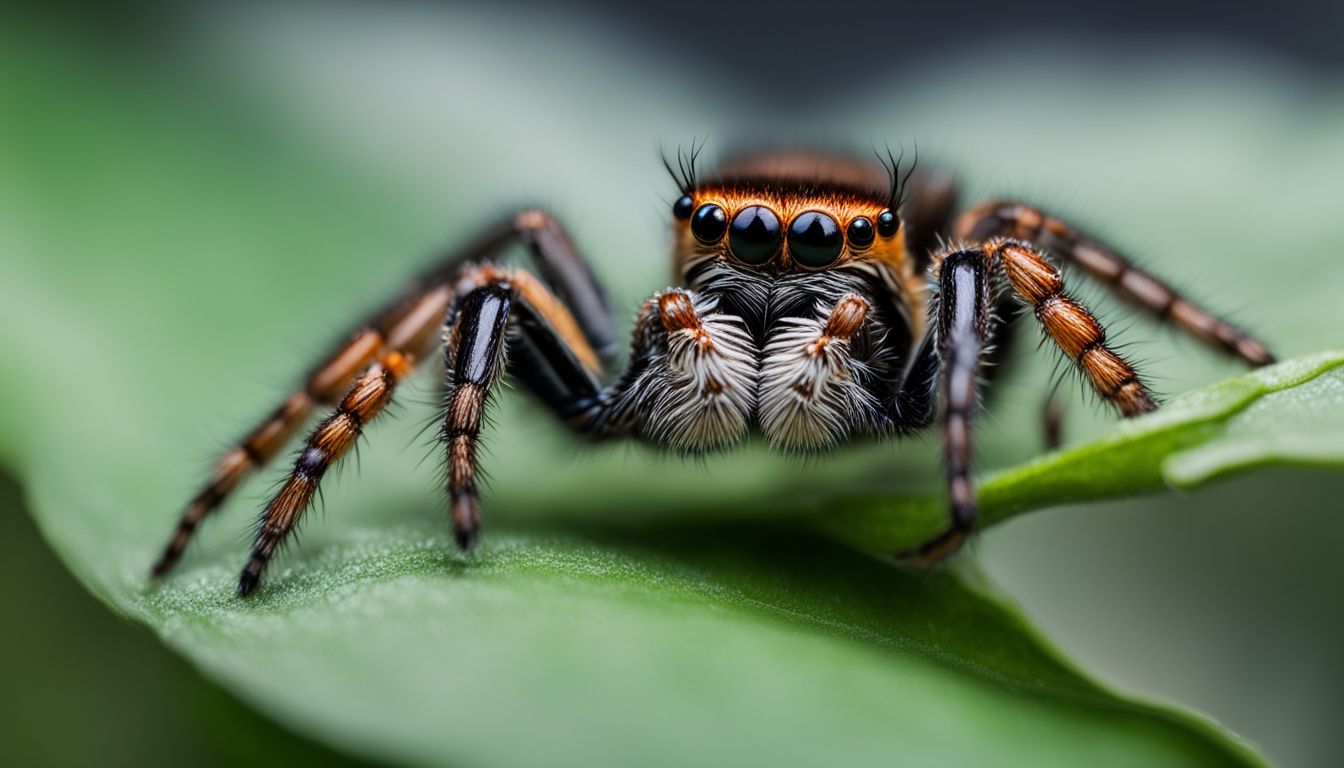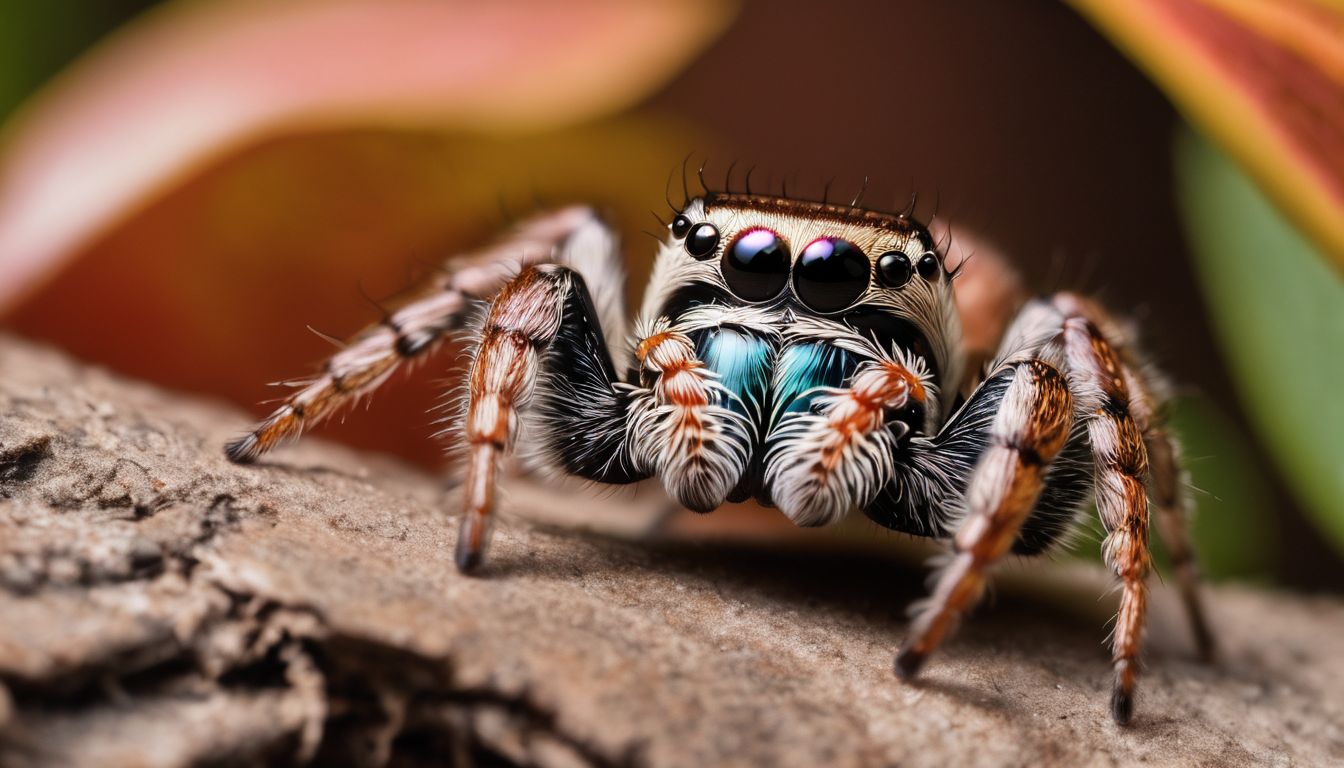Are you curious if your eight-legged friend will snack on insects that have already met their end? It’s true, jumping spiders can eat dead insects, but they might miss out on some key nutrition.
This guide dives into the fascinating world of these tiny predators and how best to feed them for optimal health. Don’t worry; we’ve made it simple to understand, so keep reading!
Key Takeaways
- Jumping spiders prefer live prey for their nutrition and hunting instincts, but they may eat dead insects if necessary, especially when kept as pets or in captivity.
- Feeding jumping spiders only dead insects can lead to nutritional deficiencies and health concerns, making it crucial to provide a varied diet with the freshness of prey to maintain their well-being.
- Providing a diverse diet including live insects such as crickets, roaches, flies, and mealworms is essential for the optimal health of pet jumping spiders. Freshness of prey should be ensured to stimulate their hunting instincts.
Understanding Jumping Spiders’ Predatory Nature

Jumping spiders are known for their predatory nature, preferring live prey over dead insects due to the nutritional differences between the two. This section will explore their feeding habits and the importance of live food in their diet.
Preference for live prey
Jumping spiders are natural hunters and they love to catch their food. They enjoy the chase and need to see their prey moving to get excited about eating it. Live insects like crickets, ants, and grasshoppers are perfect for them.
These bugs move around a lot, which is just what jumping spiders want.
Live insects give jumping spiders important nutrients that they need to be healthy. Food that moves helps keep the spider’s hunting skills sharp. This keeps them happy and in good shape.
Dead bugs might not offer all these benefits because they don’t move or smell the same as live ones do.
Nutritional differences between live and dead insects
Live insects wiggle and run, making them great food for jumping spiders. This movement helps the spider know its food is fresh. Live prey also has more nutrients that keep the spider healthy.
These important parts of their diet help give energy and help them grow well.
Dead insects are different. They may not have as much good stuff in them because they stop moving and start to break down. This means they can make a spider less healthy if it eats too many.
So while live bugs make spiders strong, dead ones might not be as good for them.
Now let’s look at when jumping spiders might eat dead bugs anyway.
Circumstances When Jumping Spiders Eat Dead Insects

Jumping spiders may resort to eating dead insects when live prey is not readily available, especially in captivity. In the wild, they may also scavenge on dead insects if necessary.
Availability of prey
Sometimes jumping spiders find it hard to catch food. In the wild, insects may be scarce because of weather or other creatures eating them first. Jumping spiders might eat dead bugs if they can’t hunt live ones.
They are opportunistic feeders and will grab a meal where they can.
In homes or labs, these spiders might get more dead insects to eat. This happens because people give them insect food that’s not alive, like wax worms. The next part talks about the differences between living in the wild and living in a place with humans.
Captivity vs. wild environments
In captivity, jumping spiders will eat dead insects as a food replacement. They adapt to the availability of prey and may consume dead insects provided by their owners. On the other hand, in the wild, jumping spiders are primarily active hunters and prefer live prey.
However, they can scavenge dead insects if the opportunity arises due to limited access to live prey. This reflects their adaptive nature based on their environment.
Jumping spiders’ diet is influenced by their surroundings and living conditions.
Potential Risks of Feeding Dead Insects to Jumping Spiders
Feeding dead insects to jumping spiders may lead to nutritional deficiencies and health concerns, as they require a well-balanced diet for optimal health. It’s important to be aware of the potential risks when considering their diet.
Nutritional deficiencies
Feeding jumping spiders only dead insects could lead to nutritional deficiencies over time. The high protein content and relatively low lipid and carbohydrate content of spider diets means that they likely rely on the catabolism of nutrients, making a well-balanced diet important for their health.
Therefore, it’s crucial to provide a varied diet to ensure that jumping spiders receive all the necessary nutrients for their growth, reproduction, and survival.
The nutritional composition of diets can vary widely in nature and have large effects on the overall health of jumping spiders. This makes it essential to prioritize live prey as it provides more nutritious options compared to dead insects which may lack sufficient nutrients required by these tiny predators.
Health concerns
Feeding dead insects to jumping spiders can lead to health concerns. Overfeeding can cause problems like obesity and a shorter lifespan. Jumping spiders need a balanced diet for their well-being, just like humans do.
It’s important to provide them with the right amount of nutrition from live prey to keep them healthy.
Jumping spiders’ health is crucial for their longevity and vitality. Next, let’s explore the best practices for feeding these fascinating creatures.
Best Practices for Feeding Pet Jumping Spiders
Ensure that you provide a varied diet for your pet jumping spider and always ensure the freshness of the prey. This will contribute to their overall health and wellbeing.
Providing a varied diet
To keep pet jumping spiders healthy and nourished, it’s essential to offer them a diverse diet. This means including a range of insects like millipedes, wasps, beetles, and even other arachnids.
By providing a varied diet, you can help prevent any potential nutritional deficiencies that might arise from only feeding them one type of prey. Remember that a diverse diet is key to ensuring your pet jumping spiders get all the nutrients they need for growth and overall well-being.
Ensuring a varied diet for pet jumping spiders not only helps in preventing nutritional deficiencies but also mirrors their natural feeding behavior in the wild. This can contribute significantly to their health and longevity as captive pets.
Ensuring the freshness of prey
Ensuring the freshness of prey is vital for your pet jumping spider’s health. You should provide live insects like crickets, flies, roaches, mealworms, and moths as their main food source.
Feeder insects need to be lively and active to stimulate the hunting instincts of your jumping spider. Additionally, avoid feeding spiders with dead or old prey as it may not have enough nutrients beneficial to your pet.
Jumping spiders are skilled hunters who rely on their quick reflexes and agility to catch their prey. To ensure they get the best nutrition possible, it’s essential to offer them fresh and lively insects.
Common Questions About Jumping Spiders’ Eating Habits
How often should I feed my pet jumping spider? What types of insects are suitable for their consumption? These are common questions that beginners have when it comes to feeding jumping spiders.
Let’s explore the answers in detail.
Frequency of feeding
Jumping spiders kept as pets should be fed 2-3 times a week. This ensures they get enough food and stay healthy in captivity. In the wild, jumping spiders eat whenever they find prey, but for pet ones, regular feeding is essential.
When caring for pet jumping spiders, it’s important to remember that they need to feed every 2-3 days to thrive. Keeping up with this routine helps them stay active and healthy like they would in their natural habitats.
Types of insects suitable for consumption
Jumping spiders enjoy a diet of live insects. They prefer small, lively prey like crickets, flies, roaches, mealworms, and wax worms. These insects are rich in nutrients that help the jumping spiders stay healthy and active.
To ensure your pet jumping spider’s health, it’s essential to provide a varied diet including these suitable insects. The live prey helps the jumping spiders get the necessary nutrition for their wellbeing and growth.
Conclusion
In conclusion, it’s clear that jumping spiders have diverse eating habits. They primarily rely on live prey for optimal nutrition, but they will consume dead insects if necessary. When caring for pet jumping spiders, providing a varied and fresh diet is essential to their health.
Understanding their dietary needs ensures these fascinating creatures thrive in captivity or the wild.
example. com/how-get-rid-joro-spiders/” is not relevant to the blog topic’s outlines, hence it has not been included in the new blog outline. )
Jumping spiders, known for their keen hunting skills and exceptional vision, typically prefer live prey. Live insects provide essential nutrients that may not be present in dead ones.
In the wild, jumping spiders hunt and consume live insects like flies, moths, and ants. However, when these spiders are kept as pets or in captivity, they are often fed dead insects as a food replacement due to the unavailability of live prey.
It’s crucial for pet owners to ensure that the dead insects provided are fresh and not nutritionally deficient to maintain their spider’s health.
Jumping spiders have specific dietary needs that require a balance of nutrients found in various live insect species. Ensuring a varied diet for pet jumping spiders while focusing on the freshness of their prey is vital for maintaining their health and well-being.
While you’re learning about jumping spider nutrition, if you’re dealing with unwanted arachnid guests in your home, check out our guide on how to get rid of Joro spiders.
FAQs
1. Do jumping spiders eat dead bugs?
Yes, jumping spiders can eat dead insects if they need to, but they prefer live food because it gives them more nutrients for a healthier diet.
2. What kind of food do baby jumping spiders eat?
Baby jumping spiders usually catch tiny living bugs like fruit flies or small earwigs that move around, which helps them grow well.
3. Can a spider only eat dead things and be okay?
If a spider eats only dead things instead of hunting, it may not get all the good stuff it needs from its food and could become malnourished or have stunted growth.
4. Are there any spiders that don’t just eat meat?
Yes! The Bagheera kiplingi is one type of jumping spider that eats plant parts as well as insects; most other kinds are obligate carnivores meaning they mostly need to eat meat to stay healthy.
5. Why do we care about what spiders eat?
Knowing what different types of spiders like Phidippus audax and Salticus scenicus eat helps people who study or keep them make sure each spider gets the right food for good health.




